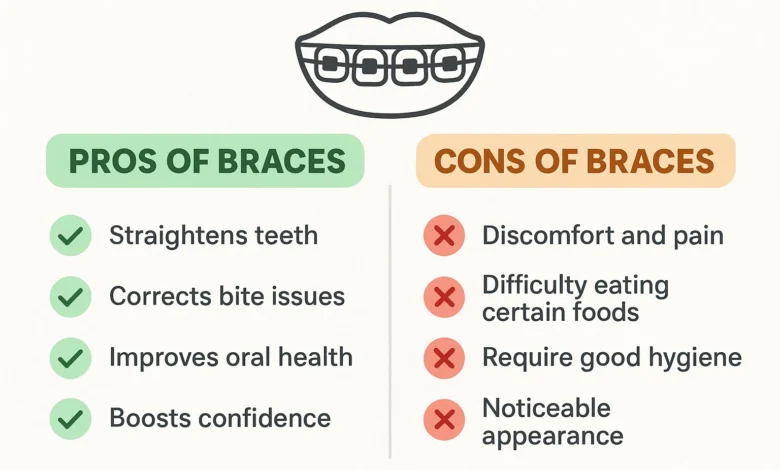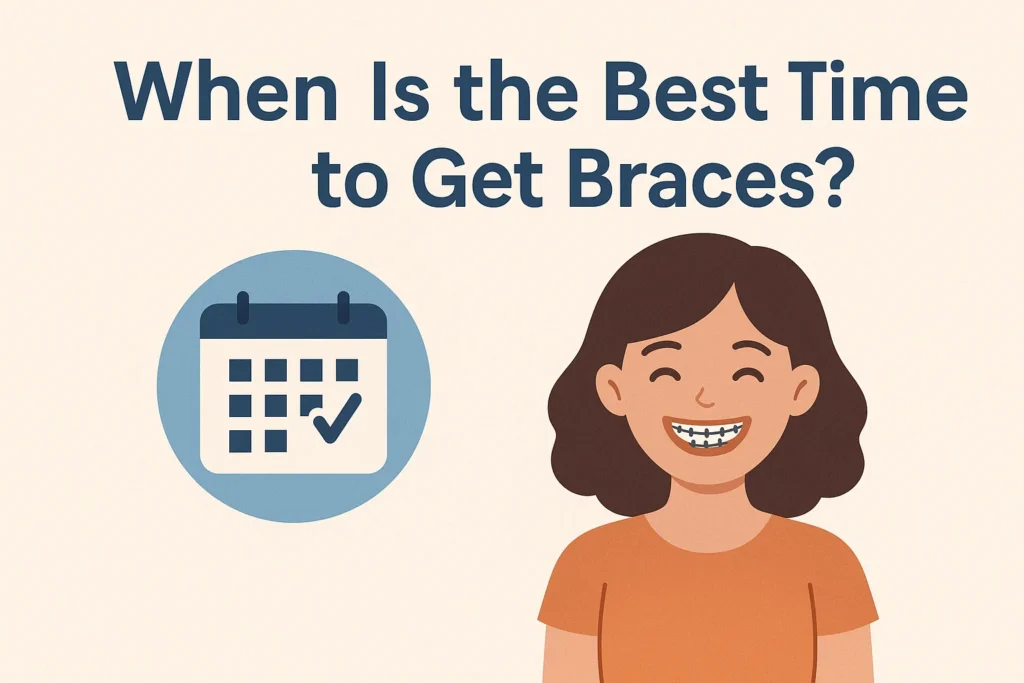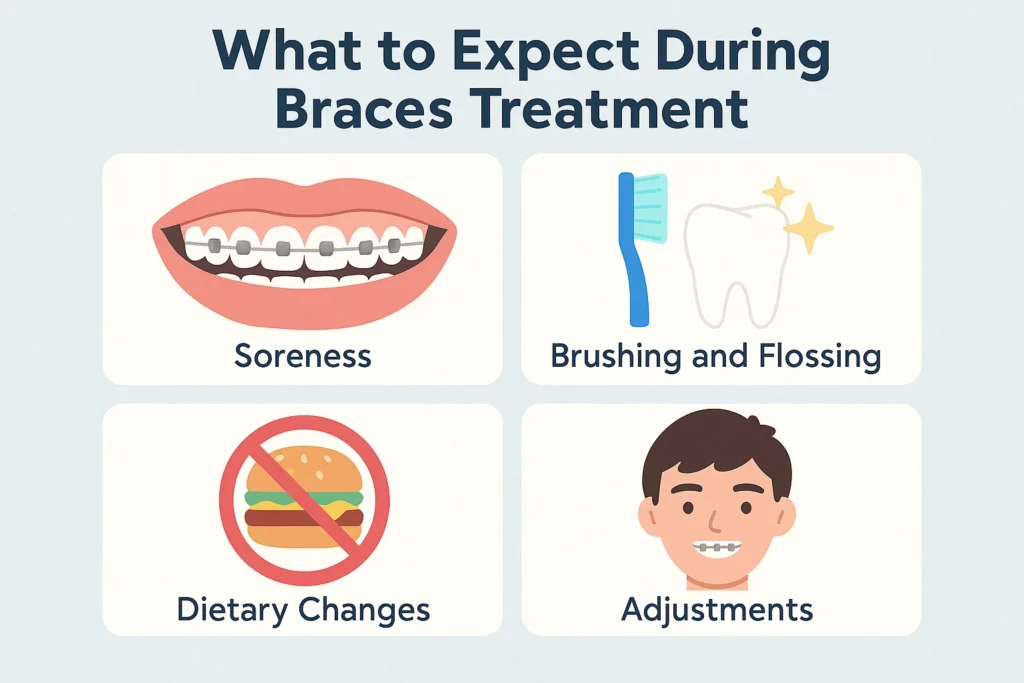Pros and Cons of Braces: How to Decide If Braces Are Right for You

Pros and Cons of Braces: What You Need to Know Before Getting Them
Introduction
Braces serve as the primary orthodontic solution to enhance both tooth appearance and functionality. The decision to get braces requires evaluating their advantages and disadvantages to make an educated choice. The process of getting braces leads to a beautiful straight smile but requires time and effort and financial costs which need thorough evaluation.
The following discussion examines the advantages and disadvantages of braces which include their ability to fix dental problems such as misaligned teeth and improper bites and their associated difficulties during wear. This guide provides complete information about what to expect from braces so you can determine if they suit your needs.
1. What Are Braces?
Braces are placed with the help of orthodontic devices and are designed to straighten teeth, correct bite issues, and enhance the functionality and health of the teeth. Each tooth moves through a gradual and continuous process of shifting and in the right direction using continuous forces from brackets, wires, bands, and ligature which are the primary components of braces.
Braces are to be made of plastic, metal, or glass ceramic. Depending on one’s dental issues, they are usually worn for a period of 12 to 36 months. To ensure teeth are moving in the right direction, frequent adjustments are made through the course of treatment.
With this information in mind, we shall now look into the advantages and disadvantages of braces.
2. Pros of Braces
Braces offer several advantages, especially when it comes to correcting a variety of dental problems. Below are some of the key benefits of getting braces:
Improved Appearance
Improved appearance is among the key benefits of having braces, and it is also the most significant one. Following treatment, most patients with societal, psychological, or emotional concerns resulting from having misaligned, crooked, or irregular teeth express having their self-esteem restored. Smiling with confidence is known to uplift one’s overall appearance, and self-esteem, alongside social acceptance.
Correct misaligned teeth braces always position your teeth at the prescribed angles, and it helps with correcting crooked, crowded, or even teeth with gaps.
Add braces if you have or even looking to get braces, you can also reduce an unbalanced smile and enhancing one’s facial muscles which contributes to overall self-image.
Better Oral Health
Braces serve two purposes by enhancing tooth appearance while simultaneously enhancing overall dental wellness. Proper alignment of teeth makes them simpler to clean which helps prevent tooth decay and gum disease.
The alignment of teeth creates difficulties for cleaning between them which results in plaque accumulation and cavities and gum issues. Braces achieve proper tooth alignment which enables better access for oral hygiene practices.
The alignment of teeth through braces creates conditions that prevent gum inflammation and disease from occurring.
The alignment of teeth through braces prevents excessive wear on teeth because misaligned teeth experience uneven pressure distribution. Braces distribute pressure evenly across teeth to prevent this issue.
Enhanced Self-Confidence
A beautiful smile can have a profound effect on your self-confidence. People with straight teeth tend to smile more often, and this can positively influence their social and professional lives.
Improved Social Interactions:Individuals with aligned teeth express a greater sense of confidence during social interactions, which subsequently enhances their self-esteem and improves overall engagement with others.
Improved Speech and Bite Function:Braces assist in aligning jaw incompatibilities, which may enhance articulation. If speech issues occur due to an incorrectly aligned dental structure, braces may yield improvements over time.
Long-Term Benefits
Although braces necessitate an initial investment of time and resources, the rewards are enduring and can last a lifetime. Maintaining proper oral hygiene is easier with straight teeth, and avoiding severe overbite or underbite alignment issues supports long-term dental health.
Avoiding More Serious Dental Issues: Jaw pain, worn-down teeth, or even tooth loss can occur as a result of misalignment not being addressed with braces.
Better Overall Function:Braces enhance the aesthetics of the teeth as well as their functionality. They assist in resolving bite problems that hinder proper chewing, speaking, and general comfort.
3. Cons of Braces
While braces offer several benefits, they also come with some disadvantages that are important to consider. Below are the common drawbacks of braces:
Discomfort and Pain
Among the principle disadvantages of braces is the soreness and discomfort associated with wearing them. The gradual shifting of the teeth into the desired position makes the process rather uncomfortable, particularly after the routine adjustments.
Initial Discomfort:Following the initial fitting of braces, as well as after every adjustment, soreness in the gums and teeth is to be expected.
Painful Sores:The use of brackets and wires can lead to orthodontic appliances which may irritate the oral cavity and cause painful lesions on the gums or cheeks.
Adjustment Period:Each adjustment of the braces can induce a certain degree of soreness as the teeth align into the appropriate position due to the force applied.
Maintenance and Cleaning
Braces require diligent care and maintenance to keep your teeth clean and your braces in good condition. This can be time-consuming and a little challenging, especially when it comes to flossing and brushing.
Extra Care:It will be necessary to brush after each meal to clean food debris associated with your braces. Orthodontic flossers or threaders specifically designed for braces may be required to floss around the brackets effectively.
Difficult to Clean:The regions confined by your brackets and wires pose cleaning challenges and may result in plaque accumulation that could lead to caries or periodontal disease without sufficient hygiene intervention.
Dietary Restrictions
With the application of braces, there are specific types of food that bones need to be avoided in order to prevent damage to the braces. Hard, sticky, or chewy foods, to name a few, can cause brackets to loosen or wires to break.
Hard Foods: Foods like popcorn, hard candy, and nuts can break or damage the braces.
Sticky Foods: Chewing gum, caramel, or taffy can get stuck in the braces and are difficult to clean.
Chewy Foods: Foods like bagels, tough meats, or pizza crusts can cause discomfort when chewing and may damage the braces.
Treatment Time
Braces can take anywhere from 12 to 36 months to fully straighten teeth, depending on the severity of the issue. Some people may need to wear braces for several years to achieve the desired results.
Long Treatment Duration: Braces can require a lengthy commitment, especially for more complex alignment issues. Some patients may need to wear braces longer than anticipated if progress is slow.
Cost of Braces
Braces can be quite expensive, especially if you’re opting for clear or ceramic braces. The cost typically ranges from $3,000 to $8,000, depending on the type of braces, the complexity of the treatment, and your location.
Out-of-Pocket Expenses:Even with some dental insurance plans providing coverage for braces, a large portion of patients continue to incur substantial orthodontic treatment costs that need to be paid out of pocket.
Payment Plans:Although numerous orthodontists provide payment schedules, the expense linked with braces remains a financial strain for some households.
4. Alternatives to Braces
If you are not certain whether braces are the right course of action for you, there are other options available, which may be less visible or require less attention.
Clear Aligners (Invisalign)
Among the options available, Invisalign tends to be the most sought after. Unlike traditional braces, Invisalign aligns the teeth with the use of pieces of clear plastic which are molded to fit the teeth. As with braces, they can be used on both adults and teens and are virtually invisible, making them a popular option.
Lingual Braces
There are also lingual braces which are less visible as they are fitted to the back of the teeth. They are less visible as compared to traditional ones, therefore they are most suitable for people looking for a discreet option.
Ceramic Braces
Braces made of ceramics are the same as the traditional metal braces, the only difference is that the brackets used are tooth colored or clear making them less visible.
5. When Is the Best Time to Get Braces?

Although braces can be fitted at any age, the most suitable time to get them is likely during teenage years when the teeth and jaws are still developing. Most orthodontists suggest an assessment for children between the ages of six and seven and some even recommend an orthodontic consultation at this age.
Although adults are also benefitted by braces, many of them decided to get braces later in their life to fix problems which they considered normal for many years.
6. What to Expect During Braces Treatment

Once you’ve decided to get braces, there are several steps involved in the process. Here’s a quick overview:
Initial Consultation: Your orthodontist will evaluate your teeth and discuss your treatment options.
Placement of Braces: The brackets are placed on your teeth, and the archwire is threaded through the brackets.
Regular Adjustments: Every 4–6 weeks, you’ll visit your orthodontist to adjust the wires and ensure the treatment is progressing.
Retainers: After your braces are removed, you’ll need to wear a retainer to maintain your teeth’s new positions.
7. How to Care for Your Braces
Caring for your braces involves:
Brushing and flossing after meals to keep your braces and teeth clean.
Avoiding foods that could damage the braces.
Regular orthodontic checkups to adjust the braces and ensure progress.
8. Final Thoughts: Weighing the Pros and Cons of Braces
When evaluating a decision to get braces, it is critical to reflect on the advantages and disadvantages associated with getting braces. Similarly, the discomfort and aggravation associated with braces may include soreness, upkeep, a restricted diet, and even a financial burden. Regardless of the struggle braces present, refined smiles and better oral hygiene remain attainable.
It is my suggestion that the upsides of braces, specifically proper oral hygiene, a refined smile, and improved confidence, surely balance the downsides, and this is mainly true if the patient is fully engaged and cooperative. Patients who adhere to instructions stand to significantly benefit from the treatment and walking away with a satisfied smile.
Toothpaste for Braces: The Best Options for Keeping Your Smile Clean



